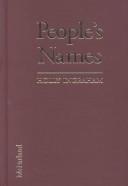Check nearby libraries
Buy this book

According to the reviewer at Oxford University, People's Names: A Cross-Cultural Reference Guide to the Proper Use of Over 40,000 Personal and Familial Names in Over 100 Cultures is the largest multicultural onomastic reference book in the English language. It actually has over 80,000.
It is aimed at a popular rather than academic audience: teachers, HR directors, anyone who deals with people, but especially at writers of fiction. (The original working title was How to Name Your Character and it never lost that orientation.) To prevent the text from being intimidating, it is not footnoted, but the Select Bibliography in the back is a guide to the author's sources.
The book is divided into two sections initially. The first is Contemporary Names, names in current usage from groups all over the world, grouped geographically rather than merely being alphabetized. Every section lists personal names, family names if used, what order they go in, and other sorts of personal attachments, like patronymics or titles, that some cultures require. Of course, all lists are merely samples, since listing all Italian family names alone would be a book, but they are large samples of hundreds of names, not merely dozens.
The second is Historical Names, which does not start at the beginning of recorded names, but rather moves back in time from the present. The onomastica (cultural groups of what's considered a name) are clustered by period, then geography, so that Renaissance French names are with other Renaissance-era names, and earlier forms in Medieval French names in the section with Medieval Kashmiri names. This goes back through the ancient world to Sumerian names. Of course, only those of which we have written records could be covered, but they include the difficult to find, like the Etruscan.
Finally, there is a guide to creating Shadow Languages, what would now be called conlangs, but in a light way that doesn't require constructing grammar and getting into formal linguistics. There are lists of possible sounds to use, from the obvious to what looks bizarre to English speakers (but in that case, there are always examples of a source in the real world). The list of roots to be sure to cover for geographical as well as personal names, since they often overlap, is unique. An example of a Shadow Language and the names built in it finishes off the book.
Check nearby libraries
Buy this book

Previews available in: English
Subjects
Slavic names, ancient names, Ancient Greek names, Ukrainian names, Korean names, Russian names, Magyar names, Latin names, Burmese names, Aztec names, Hindi, Hungarian names, Egyptian names, Lakota names, Hindu names, Viking, Scandinavian names, Assyrian names, Irish names, Mayan names, Tibetan names, Lenni Lenape names, Japanese names, African names, European names, conlangs, British names, foreign names, Roman names, Celtic names, Belorusan names, Akkadian names, Cymru, Biblical names, Indian names, Swahili names, Asian names, Tamil names, Inca names, Plains Tribes, Chinese names, Medieval names, Anglo-Saxon names, Welsh names, Dark Ages names, Native American names, multi-cultural reference, Migration Period, Classical names, Maya names, Cheyenne names, Germanic names, Personal Names, writer's reference, Byzantine names, Sumerian names, Myanmar, Hispanic names, Arabic names, immigrant names, naming fictional characters, Mongolian names, Hebrew names, onomastics, Turkish names, Sumerian, Gaulish names, Renaissance names, historical names, Yiddish names, Names, Personal, onomastica| Edition | Availability |
|---|---|
|
1
People's Names: A Cross-Cultural Reference Guide to the Proper Use of over 40,000 Personal and Familial Names in over 100 Cultures
January 1997, McFarland & Company, McFarland & Co.
Library binding
in English
0786401877 9780786401871
|
aaaa
Libraries near you:
WorldCat
|
| 2 |
zzzz
|
Book Details
Table of Contents
Classifications
The Physical Object
ID Numbers
Community Reviews (0)
Feedback?| February 28, 2020 | Edited by MARC Bot | remove fake subjects |
| July 14, 2017 | Edited by Mek | adding subject: Internet Archive Wishlist |
| April 14, 2014 | Edited by Holly Ingraham | Made a description and put in partial tags. |
| December 4, 2010 | Edited by Open Library Bot | Added subjects from MARC records. |
| December 10, 2009 | Created by WorkBot | add works page |











